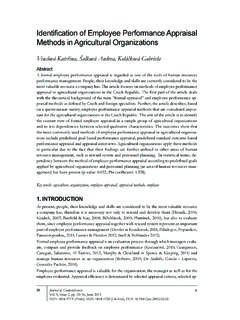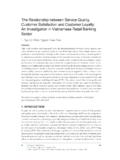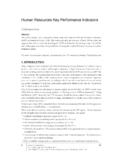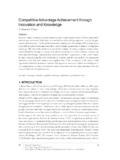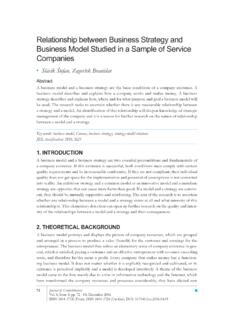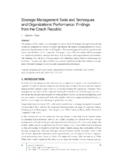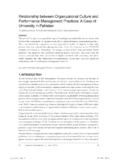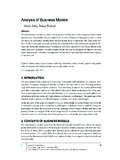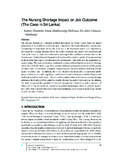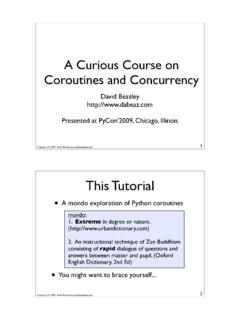Transcription of Staff Turnover as a Possible Threat to Knowledge …
1 Journal of Competitiveness | Issue 3/2011 Staff Turnover as a Possible Threat to Knowledge loss Urbancov Hana, Linhartov LucieAbstract The article focuses on labour Turnover as a potential Threat to Knowledge loss . Labour Turnover results in an organizations inability to ensure Knowledge continuity. In this study, induction was used to identify factors within organizations that determine employees exit from organi-zations. The verifiability of these factors was tested by means of correlation and regression. Subsequently, the presented causes of employee Turnover were specified as potential Threat to Knowledge loss .
2 In the current Knowledge economy, employees in an organization are consid-ered the key competitive advantage and the most important asset. If an employee leaves an organization, they take the Knowledge they have acquired with them. The loss of Knowledge is a potential Threat to an organizations existence, especially if an employee with valuable knowl-edge leaves to join a competitor. Therefore, this paper deals with Knowledge continuity as a probable means of eliminating this Threat . Dependencies between selected qualitative variables were tested to determine their impact on organizations.
3 The study concludes by indicating that, today s Knowledge -based organizations must be aware of the main causes and consequences of employee fluctuation so as to maintain their competitiveness in times of economic words: Turnover , employees, Knowledge , Knowledge continuity, competitive advantage1. INTRODUCTIONE mployee Turnover is considered to be one of the persisting problems in organizations (Arm-strong, 2009; Rei , 2008). In particular if it involves quality employees who have worked for the organization for many years, high performers and experienced and loyal individuals (Branham, 2005, Katcher, Snyder, 2007; Somaya, Williamson, 2008).
4 The Turnover means that another organization may gain a new Knowledge employee who can become its competitive advantage. The loss of Knowledge thus is a Threat for the former organization, which increases the significance of Knowledge continuity. The available sources state two main ways of Knowledge leaving organizations. Beazley (2003) and Stam (2009) state that the main danger for the coming 25 years is in particular the aging population and the retirement of strong age groups; this is supported by statistical data from organizations.
5 The second way of Knowledge loss is Turnover of labour (Beazley, 2003; Eucker, 2007). The aging population according to Stam (2009) represents two major risks for organizations, which are the underemployment of older employees and the loss of Knowledge . According to the Bureau of Labor Statistics (Harvard Management Communication Let-ter, 2003), the issue of Knowledge transfer is primarily a challenge for existing American com-panies. With downsizing, the growing mobility of labour and broader use of random workers, a high percentage of Turnover is a reality for the majority of companies.
6 Company managements have to consider how to cope with the potential leaving of their employees for competitors or 16:59:10 their retirement. It is one of the essential factors influencing Knowledge continuity and it is necessary to eliminate its consequences by means of Knowledge management and Knowledge continuity objective of the article is to identify factors determining Turnover in organizations and to specify their significance. By supporting the tested factors it is Possible to eliminate employee Turnover and thus reduce the loss of Knowledge when employees leave.
7 A partial objective is to test dependencies between selected qualitative variables in relation to Knowledge continuity ensuring, which eliminates the Threat of Knowledge loss , in the process of employee Turnover and to confirm their validity or reject them at the selected significance THEORETICAL BACKGROUND OF THE WORKT urnover or inter-company mobility is a transfer of employees between the organization and its surroundings, other organizations or institutions. It can have both desirable and unde-sirable effects (Rei , 2008). The undesirable effects may include, for example, the failure to use expertise and experience gained by a leaving employee, development of unwanted features and approaches in other employees in the organization, disruption of the attitude to work and work morale, higher demands placed on other employees during the period of substitution, Possible loss of other customers, increase of costs to recruit a replacement, his/her selection, training and adaptation (Armstrong, 2009; CIPD, 2005; Branham, 2007, Katcher, Snyder, 2007).
8 On the contrary, desirable effects are that new recruits bring new inputs and ideas, there is no stagnation, a more suitable employee (with broader Knowledge and experience) can be hired, an improved and less costly process of personnel planning, development management and succession management (Armstrong, 2009; Rei , 2008; Somaya, Williamson, 2008; St blo, 1993). Employee Turnover may also bring organizations certain benefits. For example, if a less productive employee is replaced by someone more efficient or if a retiring employee is replaced by young blood.
9 A certain level of Turnover may reduce the organization s personnel cost (Milkovich, Boudreau,1993).For employers it is very important to monitor the volume of employees who leave the organiza-tion and how this factor influences the organization. That, of course, is dependent on the size of the organization, its location and special teams of employees, etc. that can help to formulate a general strategy of sources (Hutchinson, Purcell, 2003; St blo, 1993).According to Stam (2009), organizations (irrespective of sector of economy, size of organiza-tion etc.)
10 Are facing a crisis of Knowledge management which is to ensure that employees will not leave the organization before transferring their experience. This means that organizations are facing a Knowledge preservation crisis as organizations Knowledge is threatened. In this respect Knowledge continuity management becomes a key means of reducing the risk of loss of critical , also Beazley (2003) assesses the loss of Knowledge as a serious Threat . A method of confronting this Threat is to introduce a structured programme for the transfer of critical Knowledge .
